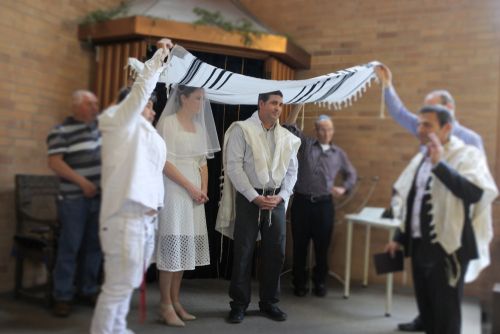 Whether you’re going to attend a Reform or strictly Orthodox Jewish wedding, there are some traditional rituals you’ll see. Some you may be more familiar with than others. Here is what you can expect from most Jewish weddings.
Whether you’re going to attend a Reform or strictly Orthodox Jewish wedding, there are some traditional rituals you’ll see. Some you may be more familiar with than others. Here is what you can expect from most Jewish weddings.
What To Wear
The dress code will vary from ultra-conservative to completely modern. At an Orthodox wedding, women will be expected to wear something that covers them from the collarbones to the knees, including their elbows. They also wear stockings or hose, and married women cover their hair. Men wear a yarmulke or kippah with a suit and tie.
At a Conservative wedding, women still dress conservatively, but the neck can be more open and they can leave the stockings at home. Married women may cover their hair, and men may be asked to wear a kippah or yarmulke.
If you attend a Reform wedding, the dress code should be covered in the invitation, and could range from casual dress to black tie.
The Chuppah
Jewish weddings take place under a chuppah, which can be a free-standing structure or four poles with cloth stretched between them held by friends or relatives of the couple to be wed. It symbolizes the home the newlyweds will build together.
Walking to the Chuppah
In Jewish weddings, each of the to-be-weds is accompanied down the aisle by their parents. First, the groom is escorted by his parents, then the bride walks down the aisle with hers. In same-sex marriages, the couple can decide who goes first.
In Orthodox ceremonies, the bride is escorted by both mothers and the groom by both fathers. The parents stand under the chuppah with the happy couple and the rabbi.
Ashkenazi traditions have the bride circling the groom either three or seven times when she reaches the chuppah. Three circles represent the three marriage virtues: justice, righteousness, and loving kindness. Seven circles embody the Biblical number that represents perfection.
Signing the Ketubah
The ketubah is the Jewish marriage contract, which outlines the responsibilities the groom has to his bride, or that the grooms have to each other in a same-sex marriage. These responsibilities include food, shelter, and sexual intimacy. The ketubah will be signed by two witnesses who are usually friends or relatives of the happy couple.
The Blessings and the Betrothal Ceremony
Two blessings are recited, one over wine that the couple then sips. The second is the betrothal blessing. To complete the betrothal, the groom will take a plain gold ring and place it on the bride’s index finger, saying in Hebrew, “Behold, you are consecrated to me with this ring according to the laws of Moses and Israel.”
The Reading of the Ketubah and the Wedding Ceremony
The ketubah is read, usually in the original Aramaic, but often in Hebrew and occasionally in English, to separate the betrothal ceremony and the wedding ceremony.
The wedding itself begins with the Sheva Berachot — the seven blessings. These may be read in Hebrew and English by friends and family members. These blessings focus on the power of love, joy, and celebration.
Breaking the Glass
This may be the most commonly recognized tradition in Jewish weddings. The groom is invited to step on a glass that’s inside a cloth bag. This symbolizes the destruction of the temple in Jerusalem, that marriages have sorrow along with joy, and that the couple is committed to weather those sorrows together.
Once the glass is broken, the congregants all yell, “Mazel tov!” which means good luck, congratulations, and good fortune. This is the community’s blessing on the marriage.
The Jewish religion is one with a long and storied history of meaningful rituals. None may be more sacred than the union of a couple in marriage. Now that you know what to expect at a Jewish wedding, you can attend one confidently and celebrate the happy couple.
Add Your Comment